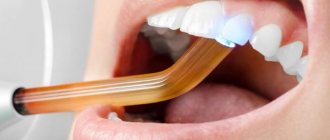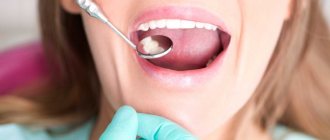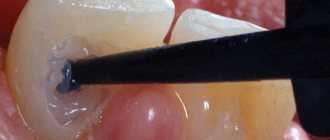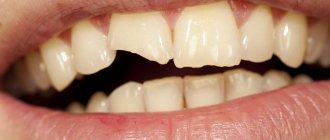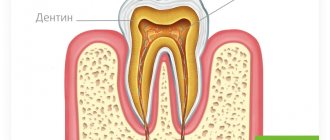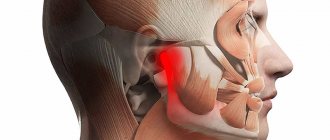Author of the article: Gadzhiev Ruslan Abasovich
Doctor-expert
Specialization: Dentist-therapist
Total work experience: since 2011
Reading time 7-8 minutes
Most often, visits to the dentist occur when pain occurs. After some procedures, for example, after removing nerves, patients expect that pain in such a tooth will never bother them again. But, over time, discomfort begins to be felt under the filling, which does not go away on its own even after taking medications. To understand why a dead tooth hurts, you need to understand and find out what exactly may be causing the discomfort.
What teeth are called dead?
The concept of “dead” is rather common, but in medicine such teeth are called pulpless (without pulp - loose fibrous tissue penetrated by nerve endings, lymphatic and blood vessels).
If living teeth are those in which there is a nerve that provides nutrition and growth, then dead teeth practically cease to receive nutrients. But, even being separated from the nervous and circulatory systems, they continue to remain a component of the dentofacial apparatus and affect the state of other units in the series.
What is vital depulpation?
Vital pulpotomy is the amputation of an inflamed nerve under the influence of anesthetic substances. Treatment is carried out in one visit to the dentist. It consists of the following stages:
- anesthesia;
- removal of tooth enamel and dentin with a drill;
- antiseptic treatment of the mouth;
- removal of tissue (fibrous substance, neurovascular bundle) from the pulp cavity and canals;
- filling channels with a composite composition;
- closing the tooth cavity with restoration materials.
Reasons why a dead tooth hurts
Pulp removal is a traumatic procedure after which the tissues need time to recover. During the first two weeks they may go away on their own. If the pain does not go away for a long time or occurs a year or more after removal of the nerve, then the reasons may be:
- poor quality treatment;
- some pathologies;
- individual characteristics.
It makes sense to consider all the reasons why a dead tooth hurts in more detail, so that, if necessary, you can seek dental help in time and prevent complications.
You might be interested in:
Dental treatment
Inflammation of the tooth root
Tooth inflammation
Tooth abscess
Poorly performed treatment
In this case, pain may be a consequence of:
- Root perforation
. Incorrect treatment resulted in the filling material extending beyond the apex of the root and into the tissue of the jaw bone. The body perceives it as a foreign body and, as a result, inflammation appears, accompanied by bursting and throbbing pain. - Incomplete depulpation
. Painful sensations when pressed may also be evidence that the pulp was poorly removed and there are remnants of living tissue in the canals. - Incomplete closure of root canals
. If the doctor incorrectly determined the length of the canal, then part of it may not be filled with filling paste. And this is a reason for infection to develop in the voids and such a dead tooth hurts when pressed. - Poor insulation during channel cleaning
. If during work the doctor poorly or insufficiently isolated the tooth from saliva, then pathogenic organisms enter the canals along with it, infecting the tissues and causing pain. - A piece of tool left behind
. To inspect the canals, special ultra-thin needles are used. Careless or inept handling of them can lead to breakage of the tip, which remains inside, causing the development of infection. - Poor/incomplete removal of caries
. If not all affected tissues are drilled out, then a dead tooth may hurt even under a filling, since pathogenic microflora continues to develop there.
Less critical reasons include installing a filling that is too high. At the same time, there is an increased load on the ligaments, they stretch causing discomfort and pain.
Some pathologies
Among them, a dead tooth most often hurts due to:
- Cysts
. Since the indication for pulp removal is infection, any extraction of root nerves increases the likelihood of an apex cyst. Symptoms may appear a year or even more after treatment and depulpation. - Inflammation of the trigeminal nerve
. If pain is observed when pressing or biting, this may indicate trigeminal neuritis. The reason is the treatment process itself (not the dentist’s mistake). To eliminate the pathology, you need to contact a neurologist.
It will not be possible to diagnose and eliminate these pathologies on your own, therefore, at the first symptoms, you should make an appointment with a dentist and, after an examination, receive high-quality, professional help.
Individual characteristics
The causes of discomfort caused by a dead tooth can be not only pathologies and incorrect treatment, but also the individual characteristics of a person. These include:
- Allergies
. Expressed in the form of intolerance to certain filling materials. Accompanied by pain, swelling and other unpleasant sensations. - Anatomical features of the bite
. An incorrect bite can cause overload of individual teeth, which leads to leaks, injuries and cracks through which infection can enter. - Specific root structure
. If a patient has a non-standard root structure, in some cases it cannot be seen even on an x-ray. Then the doctor relies only on his own feelings and works as if blindly, and the risk of incomplete treatment of the canals increases.
Sometimes, when pressed, a dead tooth hurts not for one reason, but as a result of a whole complex of dental problems. In this case, it will take more time to eliminate pathologies and discomfort in general.
How to deal with pain in a pulpless tooth
You'll have to sit in the dentist's chair again - there's no way around it. Repeated treatment usually consists of the following stages:
- Inspection and diagnostics to determine the cause of the problem. Most often, it is very easy to get answers to all the questions that arise - the patient is asked to take an x-ray. It shows the condition of the roots and the quality of canal filling. Also, from the image you can recognize the fragments of instruments forgotten by the would-be doctor. If radiography does not reveal any abnormalities - the unit is healthy, like its neighbors - the development of allergies can be assumed. Then the patient is asked to donate blood for allergens.
- Eliminating the cause of pain. Most often, to do this, the doctor removes the previously installed filling compound, opens the cavity of the dental canal and corrects the mistakes made. If the canals were processed poorly, they are sealed again. If the material extends beyond the top, the excess is removed. If there is a perforation on the face, it is covered with a special material. If there is debris, it is removed. In the case of allergies, repeated treatment must be carried out, but with the use of other medications.
- Canal filling. As soon as the negative influence of the provoking factor is eliminated, the doctor will close the dental canals and carious cavity. After this, he will conduct x-ray diagnostics again to make sure that everything is normal with the patient.
It is important to understand that even after repeated treatment, pain symptoms may still persist for some time. This is due to the occurrence of regeneration processes. You should be patient and strictly follow all medical prescriptions. If the doctor has prescribed antibiotics or some kind of anti-inflammatory drug, you must take it.
Possible complications of ignoring pain
The sensations that may occur in a pulpless tooth clearly indicate the presence of pathology, which must be eliminated as quickly as possible. Otherwise, infection will lead to quite serious consequences:
- complete destruction and/or loss of the tooth;
- acute or chronic gingivitis (gum disease);
- development of periodontitis (inflammation of the tissue surrounding the root, bone tissue of the alveoli and gums);
- chronic inflammation of the gums;
- the appearance of a cyst.
Ignoring the inflammatory process and delaying contact with the dentist can cause the development of systemic infections, which will spread throughout the body through the bloodstream from the periosteum.
Reason to visit the dentist again
If after treatment for pulpitis you continue to experience pain for a long period of time, it intensifies, the gums become red and/or swollen, or your body temperature rises, you should immediately consult a dentist.
Why shouldn't you put off visiting the doctor? If discomfort in a tooth occurs due to perforation or root fracture, then without adequate therapy the patient may be left without a tooth. And periodontitis can lead to complications such as the formation of cysts and granulomas. Important: the state of health and well-being is affected by a sluggish inflammatory process in the teeth, which is why it is so important to eliminate it in a timely manner.
Some patients, if they are bothered by painful sensations, run to the dentist immediately after therapy. Even if the treatment was performed correctly, pain may persist for several days (up to 3) after the manipulation. Discomfort for several months is considered normal, but only if it gradually subsides and the tooth does not bother you when biting or eating hot/cold food.
Specialist actions
The dentist is obliged to admit the patient and conduct an examination, assess the condition of the tissues that surround the tooth. In this situation, you cannot do without an x-ray. This will allow you to assess the quality of treatment, as well as diagnose complications or their absence.
If the painful sensations are not associated with complications of therapy or pathology, the doctor will prescribe painkillers to the patient and also advise him to monitor his condition.
The examination confirmed the worst assumptions and the patient has complications? In such a situation, the dentist will decide what further treatment tactics should be. The specialist must assess the patient’s condition.
What should you do if the doctor refuses to examine you, convinces you that the therapy was carried out correctly, but does not conduct an examination? In such a situation, you should not give up; you need to visit another doctor who will listen carefully, conduct an examination (if necessary, take a panoramic photo and x-ray). If an inflammatory process was detected during the examination, the dentist will draw up a treatment plan, perhaps this will be surgical therapy. Without this, complications may arise such as:
- periapical abscess;
- periodontitis;
- osteomyelitis;
- orbital cellulitis.
And the spread of infection from the upper teeth is fraught with purulent sinusitis, brain abscess, meningitis and cavernous sinus thrombosis.
Choosing a dental clinic
The Vash Dentist clinic provides high-quality dental services. We employ highly qualified specialists with extensive experience. It's no secret that most dentists, despite modern methods of therapy, still use “old-fashioned” methods of treatment, which most often result in tooth extraction. During treatment, doctors at our clinic use modern technologies, instruments and professional equipment.
We have the necessary certificates and licenses, all services are provided at a high level.
On our website you can find out how therapy is carried out and how much this service costs. On our website you can choose a specialist and make an appointment with him.
If you contact our clinic for treatment of pulpitis, you will not be bothered by pain after therapy. Without fail, the doctor will warn you about what consequences the treatment may entail and give recommendations on how to eliminate them as quickly as possible. If you have any questions after the manipulations, you can always seek qualified advice.
Preventive actions
Dead teeth can be considered problematic (prone to any dental disease except pulpitis), so they require more careful care. To preserve them and prevent pain, it is necessary to carry out prevention:
- Balanced diet
. Daily meals should contain sufficient amounts of essential minerals and vitamins. - Correct and thorough oral hygiene
. Use a toothpaste recommended by your dentist at least twice a day, and use dental floss and mouthwash after each meal. - Regular visits to the dentist
. By visiting the clinic once every three months, you are guaranteed to be able to identify emerging problems with dead teeth. Once or several times a year, it is worth doing cone beam computed tomography (CBCT), which is the best diagnostic technique today. The finished 3D image shows what is impossible to see in targeted and panoramic images. CBCT results allow you to study the condition of the jaws from all sides, turning images on the monitor at any angle. This technique best identifies problems with pulpless teeth even in the initial stages.
At the same time, the best prevention in this case is to avoid the need to remove the roots. Lead a healthy lifestyle, adhere to the recommended diet, regularly take care of your oral cavity, and then you won’t have to look for the answer to the question: why does a dead tooth hurt and what to do about it.
Treatment and prevention
The doctor determines the method of treating a pulpless tooth based on the results of x-ray diagnostics. The standard procedure includes:
- opening the tooth and unfilling the canals,
- complete depulpation in case of detection of pulp residues,
- thorough disinfection, treatment, grinding and filling of channels,
- restoration work to restore the anatomical shape of the tooth.
To prevent complications, follow simple rules after treatment:
- Avoid eating and drinking for 2 hours after the procedure to reduce the risk of infection,
- take anti-inflammatory drugs in the recommended dosage as prescribed by your doctor,
- Perform regular oral hygiene,
- Have it professionally cleaned every 6 months.
Read also
What to do if your tooth aches
Sometimes aching pain in a tooth can appear for no apparent reason at first glance.
Why do teeth crumble?
Tooth decay in general, and crumbling in particular, is not an aesthetic problem.
Instrument breakage in the root canal
After treatment of pulpitis, the tooth may also hurt due to a broken instrument. Part of it remains in the root canal, and unpleasant sensations occur immediately or a few days after the visit to the dental office.
The nature of the pain may vary depending on the size of the fragment and other conditions.
It is worth noting that this complication is quite rare. This is explained by the fact that a good dental clinic uses modern, high-quality instruments from reliable manufacturers that are sufficiently durable. In addition, the rules for their use must be strictly observed, including multiplicity, force during exposure, etc. And finally, the doctor will notice the presence of a foreign body in the tooth on a control image, which he will prescribe after treatment.
